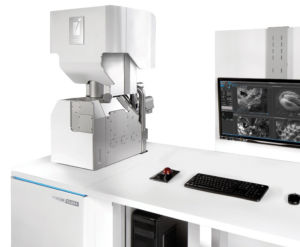
- Laboratory
- Laboratory medicine
- SEM microscope
- TESCAN GmbH
SEM microscope biological3Dtabletop
Add to favorites
Compare this product
Characteristics
- Type
- SEM
- Applications
- biological
- Observation technique
- 3D
- Configuration
- tabletop
Description
Volume SEM methods provide insights into biological material in high resolution that allows researchers to comprehensively understand the internal structure and functioning of biological systems in 3D.
The 2D imaging capability of almost any SEM can be expanded to a 3rd dimension with specialized software or hardware. Method of choice depends on the priority and character of the sample. Samples that have been sectioned beforehand, collected on a substrate as an array of serial sections (Array Tomography) can be automatically scanned with a SEM to produce a 3D stack of images. This method allows repeated scanning and the ability to go back to additional regions of interest at any time. On the other hand, a SEM equipped with a special in-chamber microtome is able to analyze volumes of exceptional dimensions in the field electron microscopy – blocks of almost one cubic millimeter can be examined.This allows us to understand the complex structural organization of cells, tissues, organs and organisms, and relationships over a large distance, such as animal connectomes.
Microscope flexibility, throughput and ease of use are of utmost importance for instruments in core facilities and imaging centers. Therefore, TESCAN volume SEMs are designed to be fully operational after only a short training session. This is possible with our modular Essence™ GUI that is configurable and predefined for specific applications. Quality of results is assured by streamlining the process from easy acquisition setup through to data processing, machine-learning assisted segmentation and visualization in a single, unified TESCAN software environment.
Related Searches
- Microscopy
- Compound microscope
- Laboratory microscope
- Tabletop microscope
- Biological microscope
- Research microscope
- High-definition microscope
- Compact microscope
- Inspection microscope
- 3D microscope
- Multipurpose microscope
- Floor-standing microscope
- Microscope for life sciences applications
- SEM microscope
- Microscope for the pharmaceutical industry
- Materials research microscope
- Environmental analysis microscope
- STEM microscope
- X-ray microscope
- Nanocharacterization microscope
*Prices are pre-tax. They exclude delivery charges and customs duties and do not include additional charges for installation or activation options. Prices are indicative only and may vary by country, with changes to the cost of raw materials and exchange rates.






